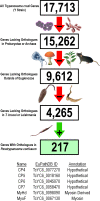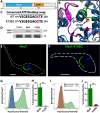The Functional Characterization of TcMyoF Implicates a Family of Cytostome-Cytopharynx Targeted Myosins as Integral to the Endocytic Machinery of Trypanosoma cruzi
- PMID: 32554712
- PMCID: PMC7300353
- DOI: 10.1128/mSphere.00313-20
The Functional Characterization of TcMyoF Implicates a Family of Cytostome-Cytopharynx Targeted Myosins as Integral to the Endocytic Machinery of Trypanosoma cruzi
Abstract
Of the pathogenic trypanosomatids, Trypanosoma cruzi alone retains an ancient feeding apparatus known as the cyto
Keywords: SPC; Trypanosoma cruzi; cytopharynx; cytostome; endocytosis; myosin; reservosome.
Copyright © 2020 Chasen et al.
Figures







Similar articles
-
Identification and Localization of the First Known Proteins of the Trypanosoma cruzi Cytostome Cytopharynx Endocytic Complex.Front Cell Infect Microbiol. 2020 Jan 17;9:445. doi: 10.3389/fcimb.2019.00445. eCollection 2019. Front Cell Infect Microbiol. 2020. PMID: 32010635 Free PMC article.
-
Short-Term Memory Impairment.2024 Jun 8. In: StatPearls [Internet]. Treasure Island (FL): StatPearls Publishing; 2025 Jan–. 2024 Jun 8. In: StatPearls [Internet]. Treasure Island (FL): StatPearls Publishing; 2025 Jan–. PMID: 31424720 Free Books & Documents.
-
Systemic pharmacological treatments for chronic plaque psoriasis: a network meta-analysis.Cochrane Database Syst Rev. 2021 Apr 19;4(4):CD011535. doi: 10.1002/14651858.CD011535.pub4. Cochrane Database Syst Rev. 2021. Update in: Cochrane Database Syst Rev. 2022 May 23;5:CD011535. doi: 10.1002/14651858.CD011535.pub5. PMID: 33871055 Free PMC article. Updated.
-
Dynamics of the orphan myosin MyoF over Trypanosoma cruzi life cycle and along the endocytic pathway.Parasitol Int. 2022 Feb;86:102444. doi: 10.1016/j.parint.2021.102444. Epub 2021 Aug 28. Parasitol Int. 2022. PMID: 34464754
-
Signs and symptoms to determine if a patient presenting in primary care or hospital outpatient settings has COVID-19.Cochrane Database Syst Rev. 2022 May 20;5(5):CD013665. doi: 10.1002/14651858.CD013665.pub3. Cochrane Database Syst Rev. 2022. PMID: 35593186 Free PMC article.
Cited by
-
Protozoan phagotrophy from predators to parasites: An overview of the enigmatic cytostome-cytopharynx complex of Trypanosoma cruzi.J Eukaryot Microbiol. 2022 Nov;69(6):e12896. doi: 10.1111/jeu.12896. Epub 2022 Mar 8. J Eukaryot Microbiol. 2022. PMID: 35175673 Free PMC article. Review.
-
A limitation lifted: A conditional knockdown system reveals essential roles for Polo-like kinase and Aurora kinase 1 in Trypanosoma cruzi cell division.Proc Natl Acad Sci U S A. 2025 Feb 25;122(8):e2416009122. doi: 10.1073/pnas.2416009122. Epub 2025 Feb 18. Proc Natl Acad Sci U S A. 2025. PMID: 40106484 Free PMC article.
-
You can go your own way: The targeting signals of trypanosomatid parasites.PLoS Pathog. 2025 Aug 1;21(8):e1013326. doi: 10.1371/journal.ppat.1013326. eCollection 2025 Aug. PLoS Pathog. 2025. PMID: 40748898 Free PMC article. No abstract available.
-
Contribution of microscopy to a better understanding of the anatomy of pathogenic protists.Proc Natl Acad Sci U S A. 2024 Apr 23;121(17):e2321515121. doi: 10.1073/pnas.2321515121. Epub 2024 Apr 15. Proc Natl Acad Sci U S A. 2024. PMID: 38621128 Free PMC article.
-
Emerging Functions of Actins and Actin Binding Proteins in Trypanosomatids.Front Cell Dev Biol. 2020 Oct 9;8:587685. doi: 10.3389/fcell.2020.587685. eCollection 2020. Front Cell Dev Biol. 2020. PMID: 33163497 Free PMC article. Review.
References
-
- Weekly Epidemiological Record. 2015. Chagas disease in Latin America: an epidemiological update based on 2010 estimates. Wkly Epidemiol Rec 90:33–43. - PubMed
-
- Mejía-Jaramillo AM, Fernández GJ, Montilla M, Nicholls RS, Triana-Chávez O. 2012. Trypanosoma cruzi strains resistant to benznidazole occurring in Colombia. Biomedica 32:196–205. (In Spanish.) - PubMed
MeSH terms
Substances
Grants and funding
LinkOut - more resources
Full Text Sources
Other Literature Sources
Miscellaneous

